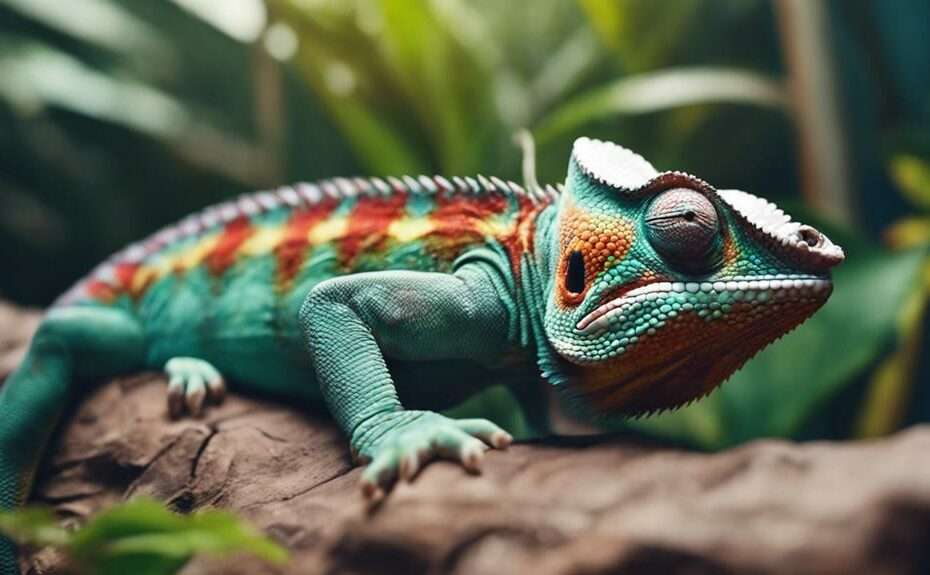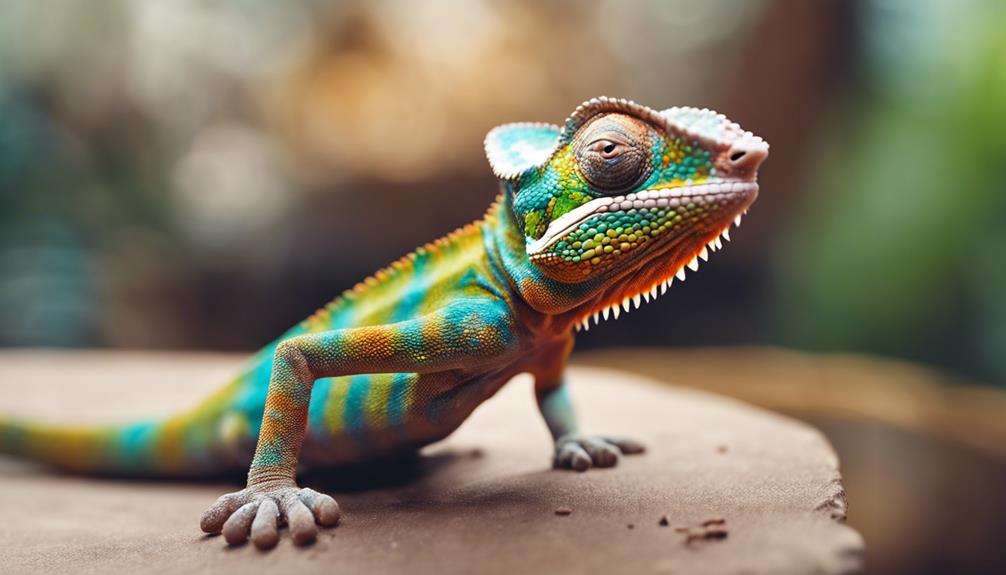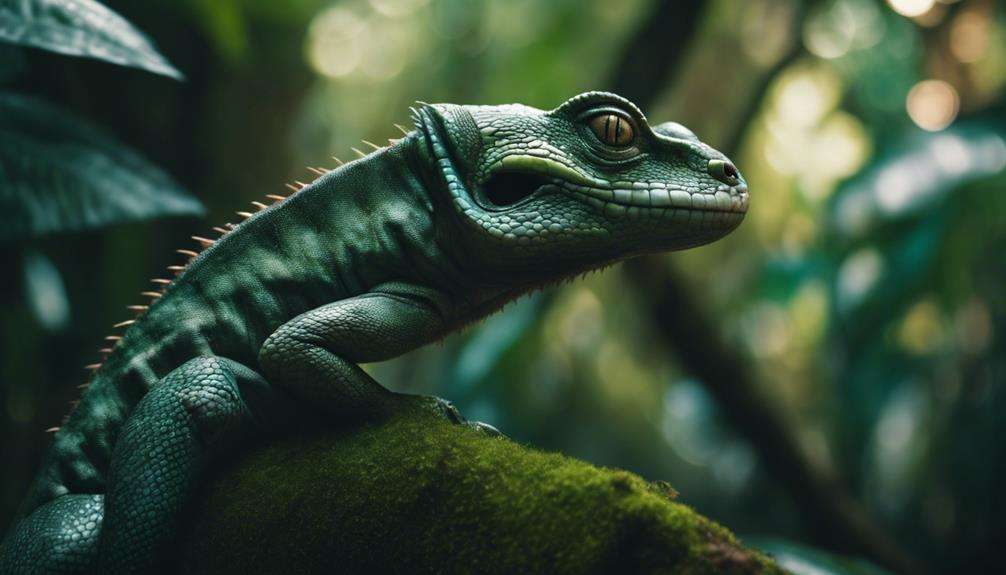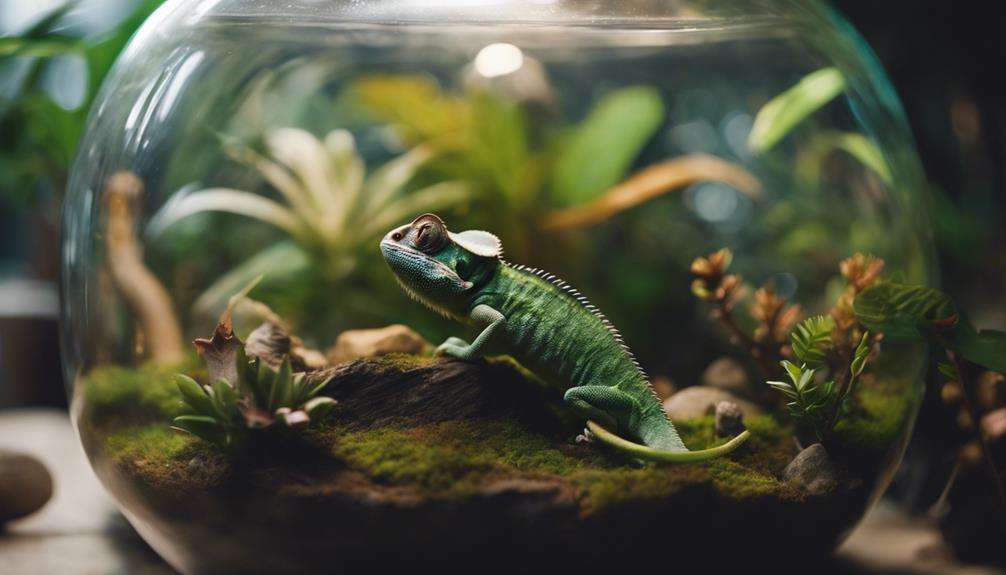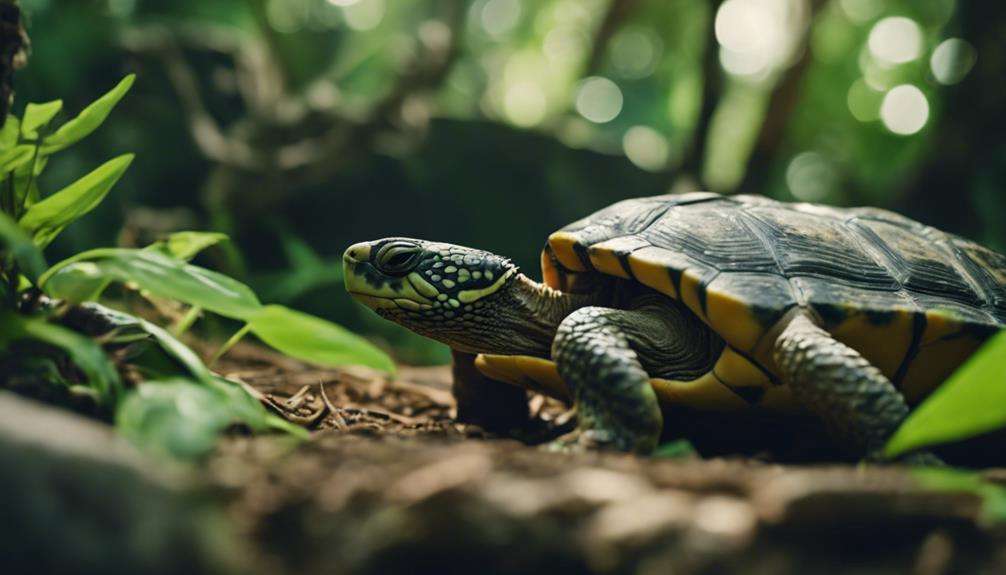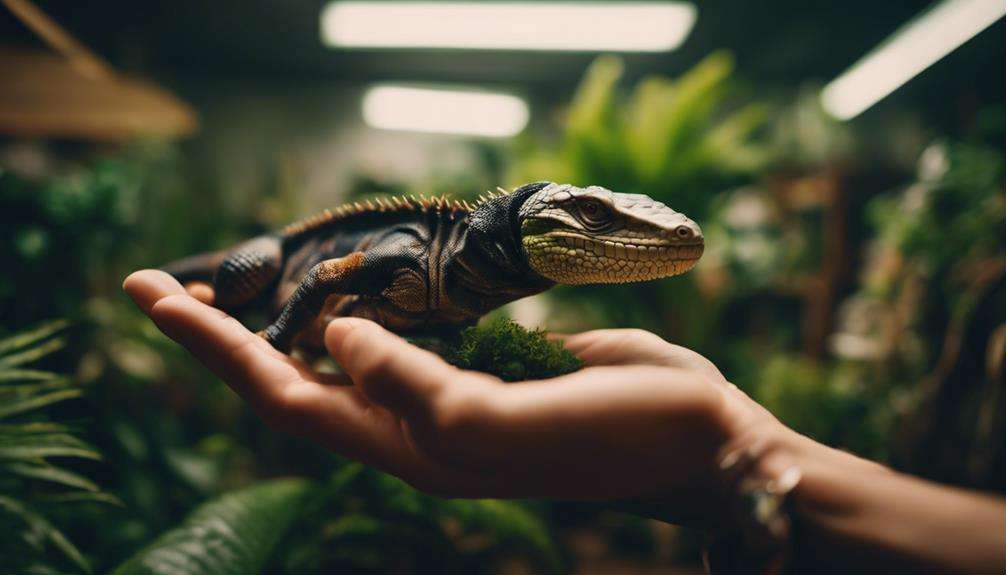You may not realize that rare reptiles can make fascinating and rewarding pets for beginners. Have you ever wondered what it takes to care for these unique creatures successfully?
Understanding their specific needs, behaviors, and habitats is crucial, but there's more to it than meets the eye. Let's explore the essential aspects of welcoming a rare reptile into your home and what it entails to ensure their well-being and your enjoyment of these extraordinary animals.
Key Takeaways
- Geckos, such as Leopard and Crested, are ideal rare reptiles for beginners due to their easy care and unique characteristics.
- Blue Tongue Skinks are perfect for novice keepers, needing warm setups and a varied omnivorous diet for optimal health.
- Leaf-Tailed Geckos, with their leaf-like appearance, require high humidity levels and a diet of gut-loaded insects.
- Rosy Boas, known for their docile nature and beautiful color variations, make unique and low-maintenance pets for observation and handling.
Geckos: Beginner-Friendly Rare Reptiles
If you're new to the world of rare reptiles and looking for a beginner-friendly option, geckos are an excellent choice. Geckos are fascinating creatures with a wide array of colors, patterns, and charming personalities. These low-maintenance pets are perfect for novice keepers. Setting up their enclosure is simple; all you need are hides, branches, and a shallow water dish for their hydration needs.
One remarkable feature of geckos is their adhesive toe pads, allowing them to effortlessly climb vertical surfaces and even walk upside down on ceilings. Leopard geckos, a popular gecko species, are nocturnal hunters that thrive on a diet of insects such as crickets and mealworms.
On the other hand, crested geckos, another beloved choice among reptile enthusiasts, are arboreal and enjoy a diet primarily based on fruit with occasional insect supplements. Geckos offer a fantastic entry point into the world of rare reptiles, providing endless fascination and joy for their keepers.
Blue Tongue Skinks for Novice Keepers
If you're looking to care for Blue Tongue Skinks, you're in for a rewarding experience!
These reptiles require a warm, secure setup with the right lighting and substrate.
Understanding their omnivorous diet and gentle handling techniques will help you bond with these fascinating creatures.
Skink Care Basics
Skink care basics for novice keepers of Blue Tongue Skinks involve creating a comfortable and enriching environment that caters to their specific needs. Blue Tongue Skinks, popular among beginner reptile enthusiasts, require a spacious enclosure equipped with proper heating and UV lighting.
Providing a substrate that allows for burrowing is crucial for their well-being. To maintain their health, a balanced diet consisting of high-quality commercial foods, insects, fruits, and vegetables is essential. Regular handling and interaction not only help in building trust but also contribute to bonding with these docile creatures.
Remember to monitor humidity levels, offer a shallow water dish for soaking, and you'll be well on your way to providing excellent care for your Blue Tongue Skink.
Handling and Temperament
When handling Blue Tongue Skinks, remember to approach them calmly and confidently to foster positive interactions and minimize stress. Due to their docile nature, Blue Tongue Skinks are great for novice keepers.
Regular handling is crucial for building trust and strengthening the bond between you and your skink. However, be aware that these reptiles may exhibit defensive behaviors like hissing or puffing up when feeling threatened. Their unique blue tongue serves as a warning signal, adding to their intriguing temperament.
Approach them with patience and respect; this will help them feel secure and comfortable in your presence. By handling them gently and consistently, you'll create a harmonious relationship with your Blue Tongue Skink.
Leaf-Tailed Geckos: Exotic Starter Reptiles
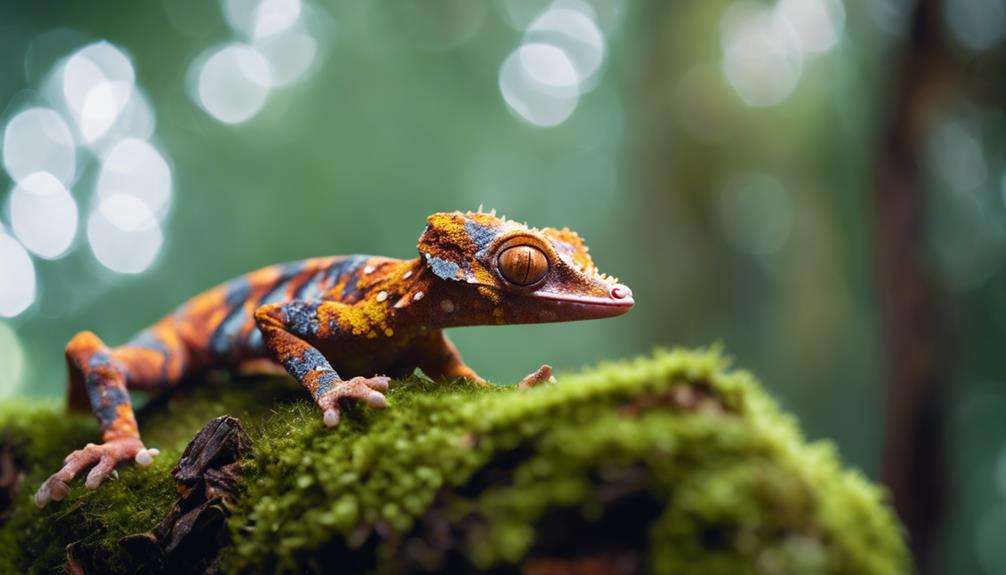
Nestled among the lush forests of Madagascar, Leaf-Tailed Geckos captivate enthusiasts with their unique leaf-like appearance and remarkable camouflaging abilities. These exotic reptiles have flattened bodies, fringed skin, and tails that resemble leaves, allowing them to blend seamlessly into their forest surroundings.
To care for these fascinating creatures, it's crucial to maintain the proper humidity levels in their terrarium. Leaf-tailed geckos thrive in environments with high humidity, replicating the moisture levels found in their natural habitat. Providing a humid hideout within the terrarium can help meet their moisture requirements and support their overall well-being.
In addition to humidity, offering a varied diet is essential for leaf-tailed geckos. These nocturnal hunters feed on insects and small invertebrates in the wild, so a diet rich in gut-loaded insects like crickets, roaches, and mealworms is recommended. Creating a spacious terrarium with plenty of hiding spots mimics their natural habitat and gives them a sense of security.
Rosy Boas: Unique Reptile for Beginners
Rosy Boas, known for their docile temperament and stunning color variations, are an ideal choice for beginner reptile enthusiasts seeking a captivating and low-maintenance pet. These small, non-venomous snakes hail from the southwestern United States and northwestern Mexico, offering a unique addition to your reptile collection. With their gentle disposition, Rosy Boas are excellent for handling, making them perfect for those new to reptile care. What sets them apart is their diverse color morphs, which include mesmerizing albino, hypo, and striped patterns, adding a touch of beauty to their already charming nature.
Due to their burrowing instincts, it's crucial to provide them with a suitable substrate that allows them to dig and feel at home. Rosy Boas have a slow metabolism, meaning they don't require frequent feeding, which contributes to their low-maintenance appeal. If you're looking for a fascinating reptile pet that's easy to care for and delightful to observe, Rosy Boas might just be the perfect choice for you.
Kenyan Sand Boas: Rare Beginner Snakes
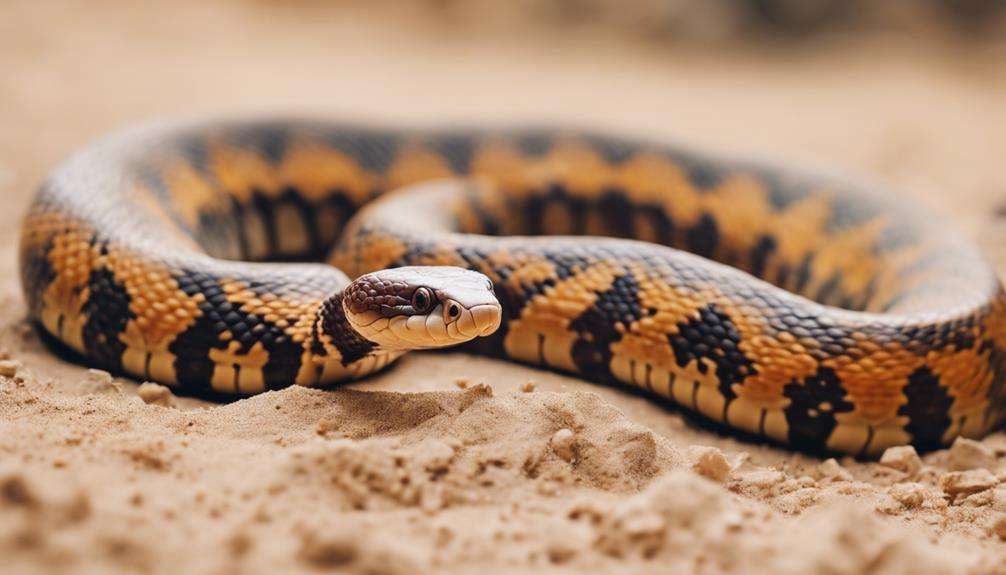
If you're looking to start your reptile-keeping journey with a unique and manageable snake species, Kenyan Sand Boas are an excellent choice. These docile creatures thrive in sandy enclosures that mimic their natural habitat, making it crucial to provide the right substrate for their well-being.
Understanding sand boa care essentials and the fascinating world of breeding these snakes will enrich your experience as a reptile enthusiast.
Sand Boa Care Essentials
When caring for Kenyan Sand Boas, providing a warm and sandy desert-like environment is crucial to ensure their well-being and natural behavior. To create the perfect habitat for your Sand Boa, consider the following:
- Substrate: Use aspen shavings or coconut husk to mimic their natural burrowing behavior.
- Temperature: Maintain a warm environment with a temperature range of 85-90°F and a basking spot of 90-95°F.
- Feeding: Offer appropriately sized mice every 7-10 days to ensure proper nutrition and growth for these unique reptiles.
Breeding Kenyan Sand Boas
Breeding Kenyan Sand Boas requires careful temperature regulation, meticulous enclosure setup, and a deep understanding of their reproductive cycle to ensure successful breeding outcomes. These unique snakes, favored by reptile enthusiasts for their manageable size and docile nature, can provide a rewarding experience in reptile ownership.
Female Kenyan Sand Boas typically give birth to live young, with litter sizes varying between 2 to 20 babies. To breed them successfully, maintain a temperature gradient in the enclosure, simulate seasonal changes to trigger breeding behavior, and introduce the male and female for mating.
Patience and attention to detail are key when embarking on the journey of breeding these fascinating creatures.
Uromastyx Lizards: Uncommon Starter Reptiles
Uromastyx lizards, fascinating herbivorous reptiles hailing from arid regions, make for an intriguing choice as uncommon starter reptiles. These unique creatures have a lot to offer to a dedicated reptile enthusiast. Here's why you should consider them:
- Colorful Personalities: Uromastyx lizards come in a variety of vibrant hues like red, orange, yellow, and green, adding a splash of color to your reptile collection.
- Specialized Diet: Their diet primarily consists of fresh food such as leafy greens, vegetables, and occasional fruits. Providing a balanced diet is essential for their health and well-being.
- Basking Beauties: Uromastyx lizards are known for their basking behavior, requiring a hot and dry environment with access to UVB lighting. Creating the perfect setup for them to bask and regulate their body temperature is crucial for their overall happiness and longevity.
Taking care of these captivating reptiles can be a rewarding experience, especially for those looking for a unique pet to care for.
Green Anoles: Easy-to-Care-For Exotic Pets
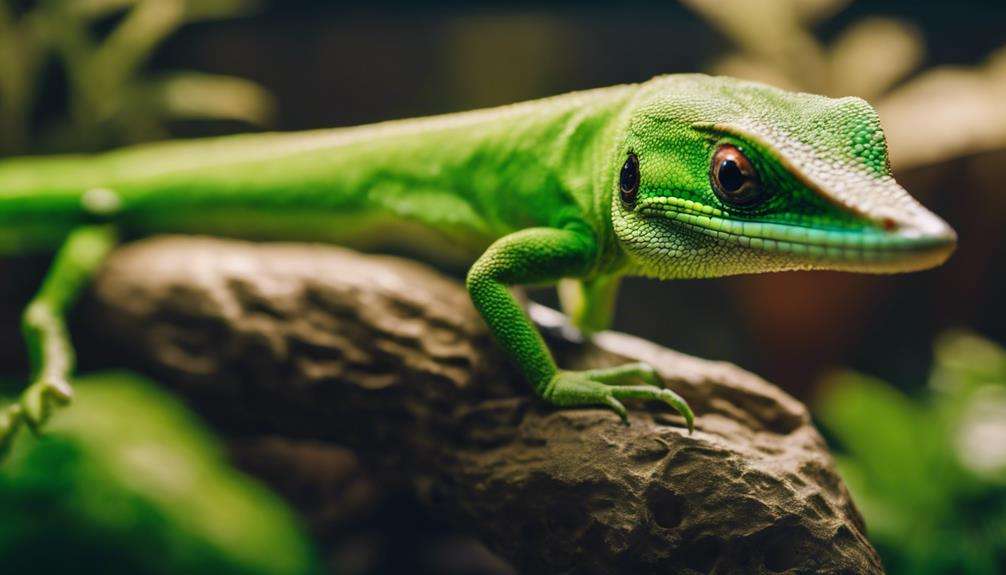
Are you ready to create a vibrant habitat for your green anole companion? Let's talk about the essential elements you'll need to set up a cozy terrarium that mimics their natural environment.
From providing climbing branches for exercise to offering a diverse diet rich in live insects, caring for these fascinating reptiles is a rewarding experience.
Anole Habitat Essentials
Creating the ideal habitat for Green Anoles involves providing a vertically oriented enclosure with ample climbing opportunities and essential environmental elements. To ensure your Green Anoles thrive, consider the following:
- Vertical Space: Opt for a tall terrarium to accommodate their climbing nature.
- Climbing Accessories: Include branches, vines, and plants to mimic their natural habitat.
- Environmental Setup: Provide a UVB light source, a basking spot for warmth, and maintain proper temperature gradients within the enclosure.
Feeding Green Anoles
To ensure optimal health and vitality for your Green Anoles, it's crucial to provide a well-rounded diet rich in essential nutrients and varied prey items. These insectivores thrive on a diet of small insects like crickets, mealworms, and fruit flies. Offer a diverse menu, including gut-loaded insects and occasional treats such as waxworms or small fruits.
Adult green anoles should be fed every other day, providing enough food for them to consume within 5-10 minutes. Juvenile green anoles may require daily feeding to support their growth. Don't forget to supplement their diet with calcium and vitamins to prevent nutritional deficiencies and promote overall well-being.
Mexican Redknee Tarantulas: Intro Tarantula Species
Mexican Redknee Tarantulas, captivating in their distinctive black bodies contrasted by vibrant red-orange knees, are revered as an iconic introductory species in the realm of tarantula keeping. These mesmerizing creatures hail from the arid deserts of Mexico, particularly in regions like Baja California and Sonora, where they thrive in the natural environment characterized by dry landscapes and sparse vegetation.
When setting up an enclosure for your Mexican Redknee Tarantula, ensure to recreate their natural habitat by providing:
- Substrate for Burrowing: Mimic the desert floor by offering a substrate like coconut fiber or peat moss for your tarantula to burrow and create its shelter.
- Water Dish for Hydration: Even though they originate from arid regions, these tarantulas still need access to a shallow water dish for hydration.
- Live Insects Diet: In the wild, they prey on insects; replicate this by feeding them live prey such as crickets or roaches.
Embrace the adventure of caring for these captivating creatures and enjoy the unique experience they bring to your world of exotic pets.
African Fat-Tailed Geckos: Beginner Exotic Reptiles
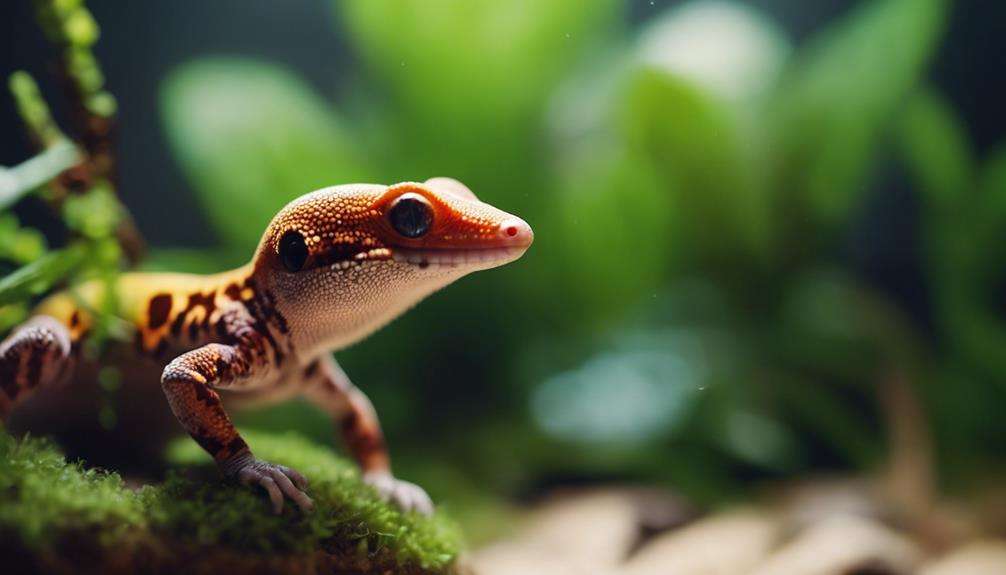
Get ready to embark on a fascinating journey into the world of African Fat-Tailed Geckos, where unique patterns and docile demeanor await your exploration. These pet reptiles, native to West Africa, are nocturnal creatures known for their fat tails that store reserves for times of scarcity. Their striking patterns and colors make them a popular choice among reptile enthusiasts looking for a captivating addition to their collection.
African Fat-Tailed Geckos are relatively easy to care for, requiring a temperature range of 75-85°F and a humidity level of 60-70% in their enclosure. As insectivores, they primarily feed on crickets, mealworms, and other appropriately sized insects, making their diet simple to manage.
Known for their docile nature, these geckos can be handled gently, but excessive handling should be avoided to prevent stress. With the right care and environment, African Fat-Tailed Geckos can make wonderful beginner exotic reptiles for those looking to experience the joys of owning a unique and fascinating pet.
Sandfish Skinks: Unusual Reptile for Beginners
Sandfish skinks, with their unique adaptations for burrowing in sandy environments, present an intriguing choice for beginner reptile enthusiasts seeking an unusual and captivating companion. These reptiles, also known as Scincus scincus, hail from North Africa and the Middle East. Their specialized features include wedge-shaped heads and streamlined bodies, enabling them to navigate through loose sand effortlessly. Here's why sandfish skinks make a fascinating addition to your reptile collection:
- Specialized Burrowing: Sandfish skinks have evolved to excel in sandy environments, showcasing remarkable burrowing abilities.
- Insectivorous Diet: These skinks primarily feed on small insects and invertebrates, contributing to their role in controlling pest populations.
- Unique Behaviors: Sandfish skinks exhibit mesmerizing behaviors such as 'swimming' through sand and burying themselves to evade predators or regulate body temperature.
With their intriguing characteristics and behaviors, sandfish skinks offer a captivating experience for reptile enthusiasts interested in observing the wonders of nature up close.
Frequently Asked Questions
What Are the Best Reptiles for a Beginner?
For beginners, the best reptiles are leopard geckos, corn snakes, bearded dragons, ball pythons, and Russian tortoises. They make great pets with manageable care needs. Set up reptile habitats properly to ensure their health and happiness.
What Is the Rarest Reptile in the World?
The rarest reptile in the world is the Ploughshare Tortoise. Endangered species like this face extinction due to habitat loss and poaching. Conservation efforts, such as breeding programs and anti-poaching measures, aim to protect them.
How Do I Start Working With Reptiles?
To start working with reptiles, begin by setting up their habitat properly. Ensure temperature, humidity, and lighting are suitable. Research their specific needs and behaviors. Join communities to learn and volunteer at rescues for hands-on experience.
What's the Coolest Reptile to Own?
If you're wondering about the coolest reptile to own, consider factors like care needs and temperament. Bearded dragons, ball pythons, or chameleons make great picks. Research specific species like Exotic Enclosures for a pet that suits you best.
Conclusion
Embark on an exciting journey with these rare reptiles, exploring their unique characteristics and care requirements. Dive into the world of geckos, skinks, boas, anoles, tarantulas, and more, each offering a special connection and rewarding experience.
Delve into the depths of reptile care and create a harmonious habitat for your new exotic companions. Embrace the challenge and charm of caring for these captivating creatures, and watch your bond blossom beautifully.
